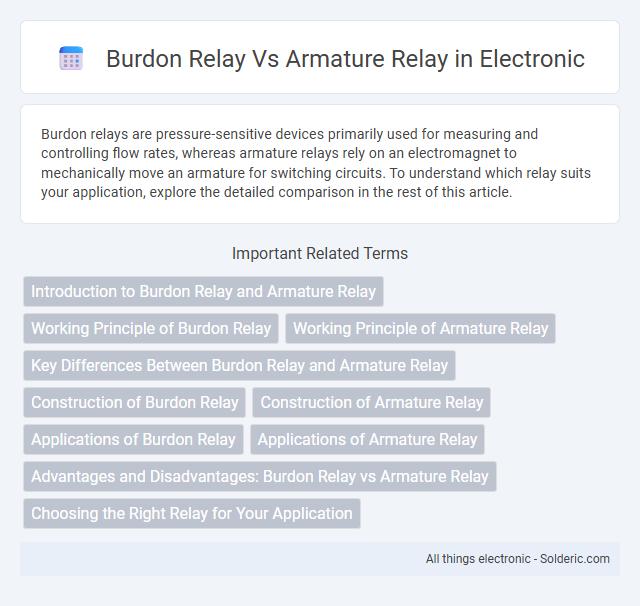Burdon relays are pressure-sensitive devices primarily used for measuring and controlling flow rates, whereas armature relays rely on an electromagnet to mechanically move an armature for switching circuits. To understand which relay suits your application, explore the detailed comparison in the rest of this article.
Comparison Table
| Feature | Burdon Relay | Armature Relay |
|---|---|---|
| Type | Electromechanical protective relay | Electromechanical switching relay |
| Function | Measures current to detect overload by torque on coil | Acts as switch to open/close circuits when energized |
| Operation Principle | Current creates magnetic torque on coil attached to moving part | Electromagnetic attraction moves armature to make/break contacts |
| Typical Use | Overload protection in electrical machines | Control circuits, signaling, and protection systems |
| Sensitivity | High sensitivity to current changes | Moderate sensitivity, depends on coil design |
| Contact Type | Usually fixed contacts actuated by torque movement | Armature actuates moving contacts |
| Construction | Coil wound on a moving soft iron core providing torque | Coil magnetizes core attracting armature pivoted |
| Response Time | Relatively slower due to mechanical movement inertia | Faster response due to direct armature movement |
Introduction to Burdon Relay and Armature Relay
Burdon relays use a coil and a moving disc to measure electrical current by detecting phase differences, making them ideal for protecting power systems against faults. Armature relays operate with a pivoted armature that moves in response to an electromagnetic force generated by coil excitation, commonly used for overcurrent protection in various electrical circuits. Understanding the distinct operating principles of Burdon relays and armature relays helps you select the right protection device for specific electrical applications.
Working Principle of Burdon Relay
The Burdon relay operates on the principle of electromagnetic induction, where a current flowing through a coil produces a magnetic field that causes a Burdon tube to deform proportionally to the current magnitude. This deformation is mechanically linked to a contact arm that opens or closes electrical contacts to signal an overcurrent condition. The relay's sensitivity and response depend on the material properties of the Burdon tube and the coil's magnetic field strength, enabling precise current measurement and protection.
Working Principle of Armature Relay
The working principle of an armature relay is based on electromagnetic induction, where a current flowing through the coil generates a magnetic field that attracts a movable armature. This movement causes the relay contacts to either close or open, enabling or interrupting the electrical circuit. Unlike Burdon relays that measure current through thermal or electromechanical means, armature relays rely on the physical displacement of the armature to perform switching operations.
Key Differences Between Burdon Relay and Armature Relay
Burdon relays utilize a sensitive Bourdon tube to detect pressure changes and operate electrical contacts, primarily used in pressure-sensitive applications, while armature relays rely on an electromagnetic coil moving an armature to open or close contacts, commonly used for general switching purposes. Burdon relays provide precise pressure measurement with gradual contact movement, whereas armature relays offer faster response times and are better suited for higher current circuits. The distinct operational mechanisms define their specific applications and influence factors like sensitivity, speed, and load handling capacity.
Construction of Burdon Relay
The Burdon relay features a coil wound around a soft iron core, with the armature designed to pivot or move in response to the magnetic field generated by the coil. Its construction includes a fixed coil and a movable armature connected to a contact mechanism that operates when the current exceeds a specific threshold. This design allows the Burdon relay to provide precise overcurrent protection by detecting abnormal current changes in your electrical systems.
Construction of Armature Relay
The armature relay features a hinged armature attached to a pivot that moves in response to the electromagnetic field generated by the coil. This construction allows the armature to either make or break electrical contacts, enabling the relay to switch circuits effectively. Its simple design ensures reliable mechanical operation and quick response times in various electrical applications.
Applications of Burdon Relay
Burdon relays are primarily used in protective relay schemes for overcurrent and earth fault detection in power systems. These electromechanical relays are favored in applications requiring precise current measurement and reliable operation under harsh electrical conditions. Their robustness makes them suitable for industrial power distribution and transmission line protection.
Applications of Armature Relay
Armature relays are widely applied in industrial control systems, telecommunications, and automotive circuits due to their reliable mechanical switching and ability to handle high current loads. These relays are favored in protective relays, motor starters, and signal switching where precise operation and durability are essential. Their robust construction allows armature relays to perform effectively in harsh environments requiring rapid response and consistent performance.
Advantages and Disadvantages: Burdon Relay vs Armature Relay
Burdon relays offer high sensitivity and rapid response times, making them ideal for precision protection in electrical systems, while armature relays provide robust construction and cost-effectiveness suitable for general applications. Burdon relays have limited mechanical strength and are more susceptible to external vibrations, whereas armature relays exhibit greater durability but generally have slower response times and lower sensitivity. The choice between Burdon and armature relays depends on balancing the need for accuracy and speed against durability and budget constraints within specific relay protection schemes.
Choosing the Right Relay for Your Application
Selecting the appropriate relay depends on your application's switching speed and load type, where a Burdon relay offers precise, low-power current measurement ideal for protection systems, whereas an armature relay provides robust mechanical switching suitable for higher current and voltage scenarios. Burdon relays excel in accuracy and faster response times, making them optimal for sensitive control circuits, while armature relays are preferred for general-purpose switching due to their durability and ability to handle inductive loads. Evaluating your system's electrical characteristics ensures you choose a relay that maximizes efficiency and reliability.
burdon relay vs armature relay Infographic

 solderic.com
solderic.com